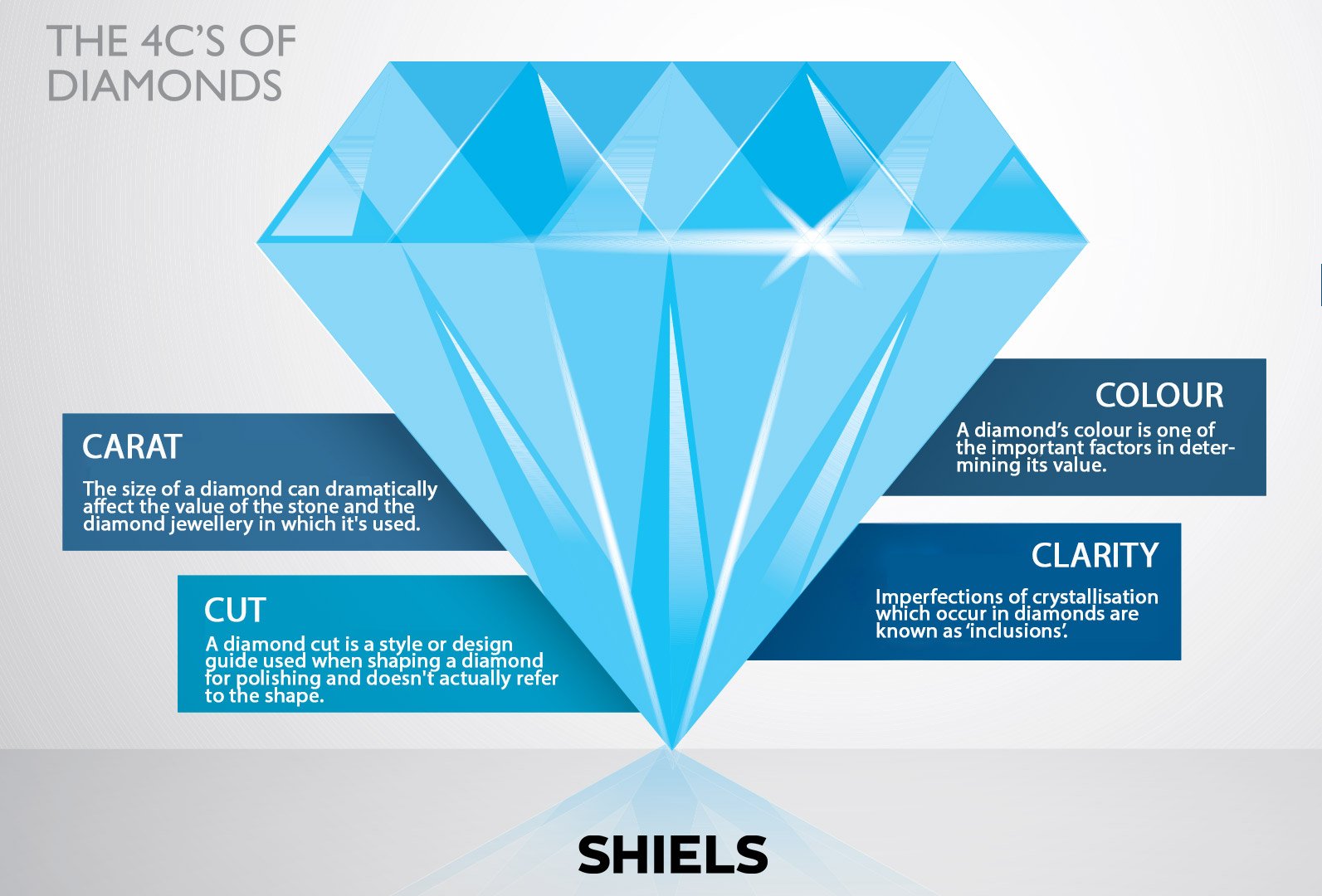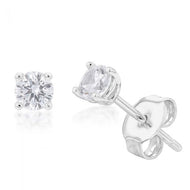Diamond simulant vs lab-created, the age-old question. What's better? Well, thanks to scientific and technological advancements, creating high-quality ethical jewellery has never been easier. Especially when it comes to sourcing diamonds.
Years ago, miners would have to venture deep into the earth's crust to source one of these rare beauties often facing the prospect of violence at the hands of the illicit and at times controversial diamond trade. That has all but changed with the creation of simulant and lab-grown diamonds.
A common misconception in the jewellery world is that simulant diamonds and lab-grown diamonds are the same thing. However, this is not the case.
Below we have deciphered some of the key differences between simulant diamonds and lab-grown diamonds so you can make the right decision when making your next bright and sparkly purchase. Jump to a section below by clicking the links or read on to find out what differentiates the two.
Overview:
-
What simulant diamonds are
- Simulant diamond pros
- Simulant diamond cons
- How lab-grown diamonds compare
- Lab-grown diamond pros
- Lab-grown diamond cons
- Lab-grown diamonds vs simulant diamonds
What Are Simulant Diamonds?
Simulant diamonds are designed to look like diamonds but are created using completely different materials. Man-made, the most well-known of the bunch is cubic zirconia or CZ which is made from a crystal form of zirconium oxide. Cubic zirconia jewellery came into the market in the early 1970s. At the time, cubic zirconias were incredibly revolutionary as they looked so much like natural diamonds that many people couldn't tell the difference between the two. The popularity of CZs has soared in the last few decades, this is largely due to these gemstones being recognised for their unique characteristics rather than being seen as just a cheap substitute. Another factor in their growing popularity is that thanks to modern technology, the quality of these simulant diamonds has never been better.
Another simulant diamond on the market is Moissanite. The more recent of the two, Moissanite is composed of silicon carbide and is lauded for being the more sparkly of the two. Much like the traditional diamond, moissanite is also naturally occurring. It was first discovered in 1893 in a crater following the Canyon Diablo meteorite. The French chemist, Dr Henri Moissan who discovered the stone at first believed he had discovered some diamonds. 11 years or so later, Dr Moissan would realise that the stones were not diamonds as they were made from a completely different compound to diamonds. Given that moissanite has only been discovered in upper mantle rock and in craters following meteors, finding this stone in the wild is rare. Hence why a majority of moissanite stones are now grown in labs.
Aside from being 1/10th the price of real diamonds, simulant diamonds are a popular choice among shoppers as they ensure your jewellery has the perfect cut, colour and clarity. They also come in an array of colours and sizes, meaning that you can sparkle without breaking the bank. If you're in the market for lab-grown diamond rings be sure to check out how they sit in different coloured metals. Of course, our lab-created yellow diamond rings timeless but have you seen how a white gold lab created diamond ring or a rose gold lab created diamond ring can sparkle?

The Pros Of Simulant Diamonds
One of the drawcards of simulant diamonds is that they are the key to a polished look for less. Simulant diamonds do not have the same physical or chemical compounds as diamonds and therefore they don't carry the same hefty price tag. This makes simulant diamonds ideal for those who travel a lot as it is less of a worry if they are misplaced or stolen. It's also ideal for savvy shoppers that want a piece that sparkles but are eager to invest their money in other ways. Simulant diamonds like CZs and Moissanite are also a great alternative for sourcing replicas of jewellery that are way out of your budget.
Another reason people tend to reach for diamond replicas is that they are completely conflict-free. Those who have seen the movie Blood Diamond starring Leonard Di Caprio will know that mining diamonds is risky business. Africa has long suffered from the consequences of diamond mining. Residents living near diamond fields have suffered horrific consequences such as child labour, violence and other conflicts.
Learn more:
The Cons Of Simulant Diamonds
One factor that has made simulant diamonds less appealing is that they are made from a completely different composite to natural diamonds and therefore they are less durable. Simulant diamonds are much softer than real diamonds, making them more prone to breakage as well as wear and tear. They will often discolour and become cloudy as they become scratched, a problem that is practically non-existent with real diamonds.
Cubic zirconias and Moissanites are also not exactly rare which means that they are largely mass-produced. This gives them little to no market value. Simulant diamonds can be picked up for as little as $50-$200. This is unheard of in the diamond world. So, if you see a diamond with a price that seems too good to be true, newsflash, it probably is and you should avoid it as you're likely being swindled.
How Do Lab-Grown Diamonds Compare?
Unlike simulant diamonds, lab-grown diamonds are made from the same composition as diamonds and are therefore ARE diamonds. Lab-grown diamonds are produced in two ways. The first is a process known as high pressure, high-temperature growth and it involves placing a diamond seed into carbon and then placing it into a machine that mimics the conditions a natural diamond is produced in. The carbon is then pressed in a specialised machine. The heat and pressure then melt the carbon into a diamond shape.
The second is a process known as Chemical Vapor Deposition. This method involves placing a diamond seed into a chamber with carbon-rich gases such as hydrogen and methane. The seed is then exposed to temperatures up to 760 degrees celsius. These gases are then ionised and melted into plasma using technology that is similar to what is used in microwaves. This process breaks down the molecular structure of the gases, allowing carbon to stick to the seed and form a diamond.

The Pros Of Lab-Grown Diamonds
With similar cut, colour, clarity and carat points, Lab-grown diamonds are the closest you can get to a naturally mined diamond without having to go into the earth's depths. Unlike the natural variety, however, lab-grown diamonds tend to be more affordable-making them a great alternative for couples looking to make that next big step.
Lab-grown diamonds also tend to be more ethical and sustainable than natural diamonds with a lower environmental impact. There also tends to be a shorter supply chain with lab-grown diamonds which could guarantee more transparency on where your stone was made.
Be sure to check out our lab-grown diamond pendants, lab-grown diamond necklaces and lab-grown diamond earrings to find out how they can be used in diamond jewellery.
The Cons Of Lab-Grown Diamonds
While sourcing lab-grown diamonds are much more sustainable than sourcing mined diamonds, the energy that is used to create these stones is immense. While the makers are exploring alternative ways to supply this energy, at this stage it is still supplied from the grid. Meaning while they leave less of a mark than natural diamonds, that carbon footprint is still there which may turn off some eco-conscious shoppers.
Due to their infancy, it is also not known what the future holds for lab-grown diamonds and whether their value will increase, decrease or stay the same. This provides a lot of uncertainty for those who aim to sell off their lab-grown pieces one day. This factor may also cause frustration if a person's lab-grown piece is ever stolen as they may not get the full amount back through their insurance.

Lab-Grown Diamonds vs Simulant Diamonds
Lab-grown diamonds which are the same compound as their natural counterparts are one of the hardest minerals found on earth. This makes them incredibly durable compared to simulant diamonds, which can be prone to wear and tear as well as scratches if they're not of good quality. Lab-grown diamonds are also a lot easier to care for than simulants. While they do require a lot of TLC every now and then to ensure your stone maintains its brilliance and lustre, the effort required is minimal but won't go unnoticed.
Where simulant diamonds really stand out is their price point. While lab-grown diamonds are a lot cheaper than natural diamonds, they are still diamonds at the end of the day. So naturally, the price is going to reflect that. Another advantage of simulant diamonds is that you can ensure the four C's: cut, colour, carat and clarity. Not only do simulant diamonds like cubic zirconias and moissanite comes in a myriad of colours, but they also have no inclusions. A natural or lab-grown diamond with no inclusions could cost you thousands.
An area where lab-grown diamonds and simulant diamonds really shine will please ethical and eco-conscious shoppers alike. While both stones require a lot of energy to produce, the carbon footprint left by lab-grown and simulant diamonds is nothing compared to that of naturally mined diamonds. When miners drill down into the earth's crust to retrieve all kinds of precious stones, they leave wounds that cannot be repaired. Miners remove and displace a lot of the earth when attempting to source diamonds. This practice is something that is avoided during the production of lab-grown and simulant diamonds. Simulant diamonds and lab-grown diamonds also spear people from the controversial world of diamond mining as they are completely conflict-free.
More About Lab-Grown Diamonds:
- What Is A Lab Grown Diamond?
- How Are Man Made Diamonds Created?
- Do Lab Grown Diamonds Last?
- Is A Lab Created Diamond A Real Diamond?
- Are Lab Created Diamonds A Good Investment?

